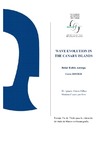Please use this identifier to cite or link to this item:
https://accedacris.ulpgc.es/jspui/handle/10553/74340
| Title: | Wave evolution in the Canary Islands | Authors: | Rubio Astorga, Itziar | Director: | Alonso Bilbao, Ignacio Casamayor Font, Mariona |
UNESCO Clasification: | 2510 Oceanografía | Keywords: | SIMAR Significant weight height trend Peak period trend Wave storm Climate change |
Issue Date: | 2020 | Abstract: | A large amount of data is currently available to study the waves conditions in a wide
part of the world. In Spain, wave data recorded at buoys and SIMAR series can be
obtained from Puertos del Estado. The goals of this study are to analyse the differences
between both wave data sources, study the evolution of the waves, establish a criterion
to define storms and estimate the trend in the Canary Islands. SIMAR series come from
the concatenation of SIMAR-44 subset and WANA subset. Results have been
calculated in 3 different periods to avoid the effect of the improvements made in the
WANA model. The parameters used are Hs and Tp. The criteria followed to define a
wave storm was established considering the 99th percentile threshold of Hs at each
selected node, a minimum duration of 6 h and an inter-storm period of 48 h. The
correlations of Hs are higher with each improvement of the model, contrary to what
happens with Tp. Furthermore, the SIMAR data underestimates the Hs values obtained
with the buoy. The obtained trends show negative values in Hs and Tp both in the north
and south with a decrease of 0.6 and 0.03 cm/year 0.02 and 0.07 s/year, respectively.
Regarding storms, the duration presents a positive trend of 0.40 min/year while Hs
decreases with an average value of 0.78 cm/year. Actualmente hay disponible una gran cantidad de datos para estudiar el oleaje en cualquier parte del mundo. En España, los datos de olas registrados en las boyas y series SIMAR se pueden obtener de Puertos del Estado. Los objetivos son analizar las diferencias entre ambas fuentes de datos, estudiar la evolución de las olas, establecer un criterio para definir las tormentas y estimar su tendencia en las Islas Canarias. La serie SIMAR proviene de la concatenación del subconjunto SIMAR-44 y el subconjunto WANA. Los resultados se han calculado en 3 periodos distintos para evitar el efecto de las mejoras realizadas en el modelo WANA. Los parámetros utilizados son Hs y Tp. El criterio usado para definir una tormenta se estableció considerando el umbral del percentil 99 de cada nodo seleccionado, una duración mínima de 6 h y un período entre tormentas de 48 h. Las correlaciones de Hs son más altas con cada mejora del modelo, al contrario de lo que sucede con el Tp. Además, los datos SIMAR subestiman los valores de Hs respecto a la boya. Las tendencias obtenidas muestran valores negativos en Hs y Tp tanto al norte como al sur de las islas con una disminución de 0.6 y 0.03 cm/año y 0.02 y 0.07 s/año respectivamente. En cuanto a las tormentas, la duración presenta una tendencia positiva de 0.40 min/año, mientras que Hs disminuye 0.78 cm/año. |
Description: | Máster en Oceanografía (2019-2020) | Department: | Departamento de Física | Faculty: | Facultad de Ciencias del Mar | Degree: | Máster Universitario en Oceanografía por la Universidad de Cádiz, la Universidad de Las Palmas de Gran Canaria y la Universidad de Vigo | URI: | https://accedacris.ulpgc.es/handle/10553/74340 |
| Appears in Collections: | Trabajo final de máster |
En el caso de que no encuentre el documento puede ser debido a que el centro o las/os autoras/es no autorizan su publicación. Si tiene verdadero interés en el contenido del mismo, puede dirigirse al director/a o directores/as del trabajo cuyos datos encontrará más arriba.
Show full item recordPage view(s)
123
checked on Nov 5, 2023
Download(s)
197
checked on Nov 5, 2023
Google ScholarTM
Check
Share
Export metadata
Items in accedaCRIS are protected by copyright, with all rights reserved, unless otherwise indicated.
